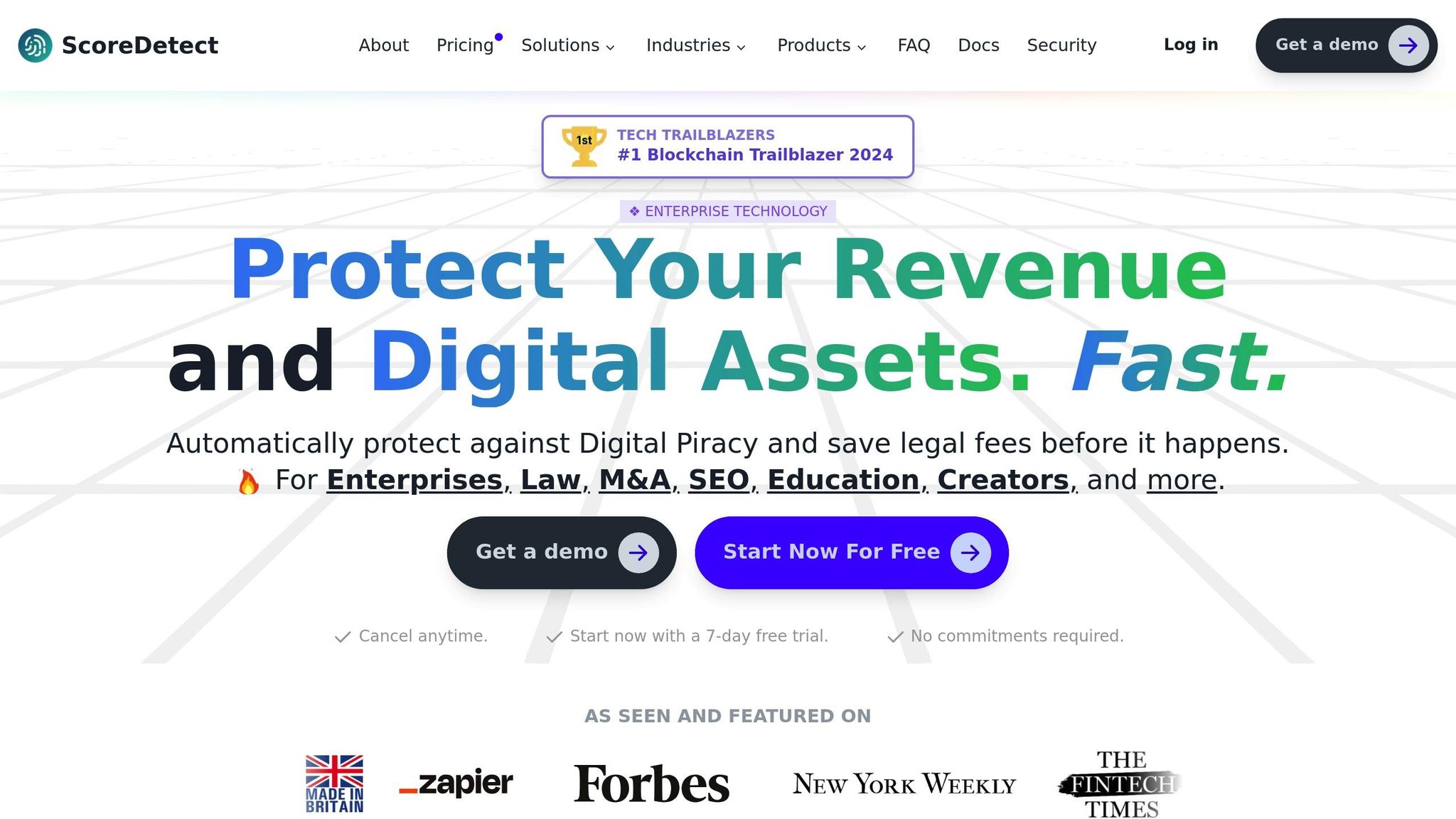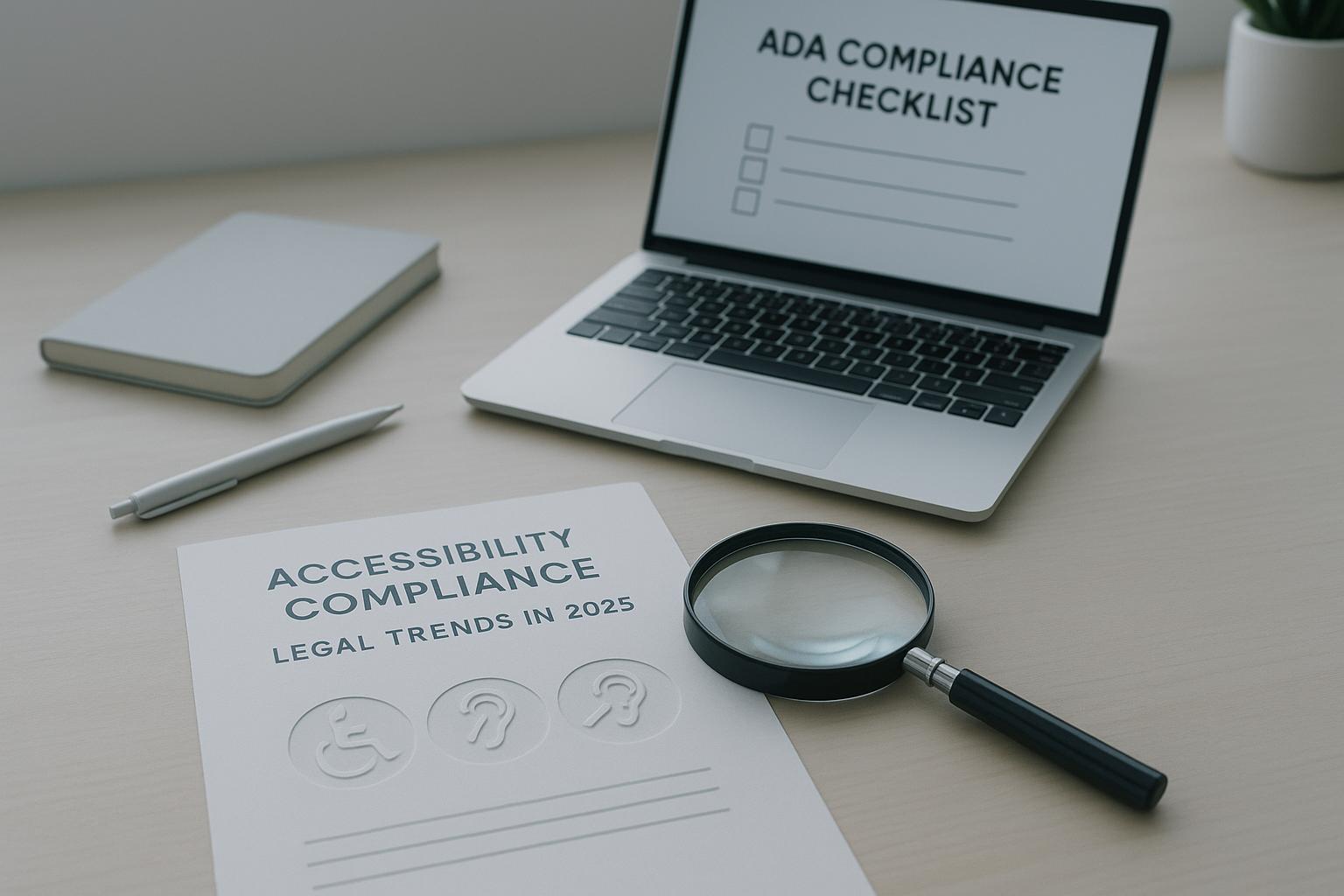The rise of digital content has made protecting intellectual property harder than ever. Two key methods – blockchain and watermarking – offer solutions to this challenge. Blockchain secures ownership with tamper-proof records and timestamps, while watermarking embeds ownership details directly into the content for tracking and deterrence. Both have strengths and limitations, and their effectiveness depends on your goals:
- Blockchain: Best for proving ownership and managing licensing with permanent, timestamped records.
- Watermarking: Ideal for identifying misuse and protecting large volumes of content with visible or invisible marks.
- Combination: Using both together enhances protection by covering ownership verification and content tracking.
For creators, businesses, and industries like media, law, and e-commerce, choosing the right approach – or blending both – can safeguard digital assets effectively.
Quick Comparison
| Feature | Blockchain | Watermarking |
|---|---|---|
| Security | High (tamper-proof records) | Moderate (marks can be altered) |
| Scalability | Limited by computing power | Easily scales across content |
| Proof of Ownership | Immutable timestamps | Embedded metadata |
| Cost | Higher setup and transaction fees | Lower upfront costs |
| Content Integrity | Original files remain unchanged | Visible marks alter appearance |
| Legal Recognition | Increasing in courts | Long-standing acceptance |
Platforms like ScoreDetect combine both methods, offering a dual-layer solution for stronger copyright protection. Keep reading to learn how these technologies work and which fits your needs.
How Can Digital Watermarks Be Used On The Blockchain To Protect Intellectual Property?
How Blockchain Works for Copyright Protection
Blockchain technology creates a permanent digital fingerprint for content. When you register your work, it generates a unique cryptographic signature, along with a timestamp and essential metadata – all without storing the actual file. Each registration or transfer is recorded in a verified chain of custody using cryptography and distributed record-keeping.
Core Features of Blockchain
Private keys and public addresses are the backbone of blockchain-based copyright systems. Upon registering your content, you receive a private key, which acts as a secure tool accessible only to you. Meanwhile, your public address functions like a visible mailbox – others can see and verify it, but only your private key can unlock it to authorize transactions [3].
Digital signatures and an immutable ledger ensure your private key remains secure. Blockchain creates a permanent, tamper-resistant record distributed across multiple computers. Once data is entered, altering or deleting it becomes nearly impossible since no single entity has control over the records [3][4][6].
Timestamping provides automatic, precise records of when content is registered or ownership changes. Each entry includes an exact timestamp, creating an undisputable chronological order that serves as evidence of ownership claims [3][4][5].
Non-Fungible Tokens (NFTs) are a specialized use of blockchain for unique digital assets. Each NFT comes with a distinct token ID and contract address, establishing clear ownership. Blockchain tracks the entire history of an NFT, from its creation (minting) to every transfer, making it easy to verify the current owner [1].
Benefits of Blockchain
Blockchain offers several advantages for copyright protection. Its decentralized nature ensures that no single authority can alter the permanent records stored on the blockchain. The transparent, tamper-proof ledger provides publicly verifiable proof of ownership, while automated timestamping delivers an indisputable chronological record of events.
Common Use Cases
One of the main applications of blockchain in copyright protection is content registration. Creators – such as photographers, writers, and musicians – can register their original works to establish a clear timestamp of creation. Ownership verification also becomes more straightforward, as the blockchain’s immutable records provide transparent proof of who owns the content and when that ownership began.
This system of permanent, time-stamped records sets the stage to compare blockchain’s capabilities with traditional watermarking methods in copyright protection, offering a solid framework for evaluating their effectiveness.
How Watermarking Works for Copyright Protection
Watermarking embeds ownership details directly into digital content, linking it back to the creator. Unlike blockchain, which relies on external record-keeping, watermarking integrates protection within the file itself. This means the identifying marks stay with the content no matter where it goes, offering a built-in safeguard. Below, we’ll explore how this approach works and how it compares to other methods.
The process involves embedding marks, codes, or patterns into digital files. These elements act like a digital signature, helping prove ownership, track usage, and discourage unauthorized copying. If someone uses the content without permission, the watermark can serve as legal proof of original ownership.
Types of Watermarking
Visible watermarking places clear, noticeable marks – like logos or text – on digital content to signal ownership. For example, stock photo websites often use semi-transparent company names across their images, and news broadcasts display network logos in the corners of the screen. This method not only establishes intellectual property rights but also promotes the brand, acting as a direct deterrent to misuse. However, visible watermarks can be removed or cropped out by those determined to bypass them, especially when they’re placed in predictable areas.
Invisible watermarking embeds ownership information into the digital structure of the content without altering its appearance. This technique modifies elements like pixels, frequency domains, or metadata in ways that are imperceptible to the naked eye but can be detected with specialized tools. Since it doesn’t affect the visual quality, invisible watermarking offers a discreet way to protect content – even if it’s copied. However, it requires advanced tools for embedding and extraction, and its effectiveness can sometimes be reduced by file modifications like compression or format changes.
Benefits and Drawbacks
Watermarking is a powerful tool for tracing content across the internet, identifying unauthorized use, and confirming ownership. Visible watermarks act as a clear warning, while invisible ones provide subtle but effective security.
That said, each method has its downsides. Visible watermarks can diminish the aesthetic appeal of the content and may be removed or cropped out. On the other hand, invisible watermarks preserve the original appearance but come with challenges like more complex implementation and potential vulnerability to file alterations.
Common Use Cases
Stock photography platforms and media companies commonly use visible watermarking to protect their catalogs while allowing previews. News outlets and broadcasters rely on persistent visible marks to maintain brand recognition and deter unauthorized redistribution.
For digital artists and photographers, invisible watermarking is often the go-to choice. It lets them protect their work without compromising its visual integrity. Beyond creative fields, watermarking is also widely used in document security to safeguard sensitive business or legal files. Additionally, it plays a role in protecting digital products by identifying legitimate copies and tracing illegal distribution channels.
sbb-itb-738ac1e
Blockchain vs. Watermarking: Side-by-Side Comparison
Understanding how blockchain and watermarking stack up can help you decide which is better suited for protecting your digital content. Each has its strengths and serves different purposes.
Comparison Table
| Feature | Blockchain | Watermarking |
|---|---|---|
| Security | High (tamper-proof records) | Moderate (visible marks can be removed; invisible ones are vulnerable to file changes) |
| Scalability | Limited by computational demands | Easily scales across large volumes of content |
| Proof of Ownership | Immutable timestamp records | Embedded metadata within files |
| Implementation Complexity | Complex setup requiring expertise | Simple and easier to integrate |
| Cost Structure | High initial costs and transaction fees | Lower upfront costs, minimal maintenance expenses |
| Content Integrity | Does not alter original files | Visible marks change appearance; invisible marks preserve quality |
| Traceability | Tracks ownership history and transfers | Detects unauthorized use across platforms |
| Legal Recognition | Gaining acceptance in courts | Long-standing recognition in legal systems |
| Best Use Cases | Ownership verification, licensing | Content monitoring, brand protection |
This table highlights the key differences, helping you align your choice with your specific needs.
When to Choose Each Technology
Deciding between blockchain and watermarking depends on your goals for protecting digital assets. Here’s a breakdown to guide you:
Choose blockchain for ownership verification and licensing. Blockchain is ideal for high-value digital assets like original artwork, music compositions, or proprietary software. Its ability to create tamper-proof records of creation dates and ownership chains makes it indispensable when authenticity and trust are paramount. It’s especially useful when multiple parties need to verify information without relying on a central authority.
Choose watermarking for monitoring and identifying unauthorized usage. This method is perfect for photographers, stock image providers, and media companies who need to protect large volumes of content. Watermarking allows for quick detection of misuse and works efficiently without the computational demands of blockchain.
Combine both technologies for comprehensive protection. A hybrid approach gives you the legal strength of blockchain for ownership verification while leveraging watermarking for practical content monitoring. This combination is particularly effective for premium digital assets where both ownership proof and usage tracking are crucial.
Ultimately, your budget and technical resources will shape your decision. Watermarking is a cost-effective choice for those with limited resources, while blockchain is better suited for safeguarding high-value assets.
ScoreDetect: Combining Blockchain and Watermarking

ScoreDetect takes a unique approach by merging blockchain technology with watermarking to create a dual-layer defense system. Instead of relying on just one method, this SaaS platform blends the strengths of both, offering a complete solution to protect intellectual property from the moment it’s created to when enforcement is needed.
How ScoreDetect Works
ScoreDetect operates through a four-step process: invisible watermarking, blockchain registration, web monitoring, and automated takedown notices. First, it applies invisible watermarks to your digital assets – whether they’re images, videos, audio files, or documents. Simultaneously, it registers a checksum on the blockchain, providing unchangeable proof of ownership without storing the actual files.
Next, the platform uses AI-based web monitoring to search for unauthorized usage. Impressively, it bypasses 95% of the measures designed to block automated detection systems. When infringement is found, ScoreDetect matches the content and provides solid evidence of misuse.
Finally, the system automates takedown notices, achieving a 96% success rate in removing infringing content. This streamlined process removes the need for manual copyright enforcement, making it far more efficient than relying on either blockchain or watermarking alone.
Key Features and Benefits
ScoreDetect stands out with a range of features designed to simplify and strengthen content protection:
- WordPress Plugin: Automatically tracks every article you publish or update, generating blockchain proof of ownership. This also enhances your SEO by boosting Google’s E-E-A-T signals.
- Zapier Integration: Connects with over 6,000 web applications, enabling automated workflows. This lets you protect new uploads or trigger takedown notices without disrupting your existing processes.
- Unlimited Content Protection: Safeguard your entire digital library without worrying about additional costs per file. The platform also keeps a complete revision history, so you can monitor changes to your assets over time.
- Enterprise-Level Solutions: Offers advanced features like 24/7 content monitoring, white-label options, and dedicated account management. Custom domain support for blockchain timestamping ensures your brand identity is preserved while providing legal proof of ownership.
Industry Applications
ScoreDetect’s technology is versatile enough to meet the needs of various industries:
- Media and Entertainment: Protects videos, music, and digital artwork from piracy. Automated monitoring ensures content stays secure across streaming platforms and social media.
- Marketing and Advertising: Shields client campaigns, creative assets, and proprietary strategies from unauthorized use. The detection system helps agencies safeguard brand integrity and prevent competitors from copying their work.
- Legal and Law Firms: Blockchain timestamping establishes clear proof of document creation dates and ownership, which is critical in intellectual property disputes.
- E-commerce: Guards product images, descriptions, and marketing materials against competitors who might misuse them. The automated takedown system ensures quick removal of stolen content from online marketplaces.
- Academic Institutions: Protects research papers, course materials, and other educational content from unauthorized distribution. Certificates generated by the platform help establish publication priority and combat plagiarism.
With the ability to handle diverse content types – documents, images, videos, and audio – ScoreDetect is a flexible solution for any industry needing robust digital protection. By combining prevention, detection, and enforcement, it offers a seamless way to safeguard intellectual property and maintain control over valuable digital assets.
Conclusion
Looking at both methods side by side, it’s clear they each bring unique strengths and challenges. Blockchain stands out for its ability to create unchangeable proof of ownership and record precise timestamps for when content is created. However, it doesn’t stop unauthorized copying or offer direct ways to trace the content itself. On the other hand, watermarking embeds ownership details directly into digital content, making it easier to track unauthorized copies and discourage piracy. But it’s not foolproof – skilled attackers can potentially remove or alter watermarks if they aren’t robust enough [1].
The real power, though, comes from using these technologies together. Research shows that combining blockchain with watermarking enhances security, efficiency, and overall reliability [2]. This hybrid approach fills in the gaps left by each individual method while amplifying their strengths. For example, ScoreDetect uses this strategy by integrating invisible watermarking, advanced web scraping, and blockchain-based checksums. This creates a system that verifies ownership without needing to store the content itself [1]. ScoreDetect’s ability to bypass detection and streamline takedown processes highlights how effective this combination can be.
For industries dealing with high-value digital assets – like media, academia, law, marketing, software, and ecommerce – this dual-layered approach offers both protection and enforcement. Instead of choosing between blockchain or watermarking, the future of copyright protection lies in blending these technologies to build a strong, adaptable defense against the ever-changing threats in the digital world.
FAQs
How do blockchain and watermarking work together to protect digital content?
Blockchain and watermarking combine to form a robust system for safeguarding digital content. Blockchain acts as an unchangeable, time-stamped ledger that confirms ownership and monitors modifications. Meanwhile, watermarking embeds discreet, non-intrusive identifiers directly into the content. Together, these technologies provide secure ownership verification, enable content tracking, and help deter unauthorized use.
When watermark data is stored on the blockchain, it creates a tamper-proof method to authenticate content and monitor its distribution. This offers a reliable way to combat digital piracy and protect intellectual property effectively.
What challenges does blockchain face in copyright protection, and how can they be addressed?
Blockchain technology presents new ways to tackle copyright protection, but it’s not without hurdles. One major concern is scalability – processing a high volume of transactions can bog down the network. Then there’s regulatory uncertainty, as laws surrounding blockchain are still catching up. On top of that, interoperability issues and the lack of widespread adoption across industries can limit its potential.
Addressing these challenges will require efforts like enhancing blockchain’s scalability and creating systems that integrate smoothly with one another. Establishing clearer legal guidelines and fostering collaboration across industries can also pave the way for consistent standards, making blockchain a more dependable tool for copyright protection.
When is it most effective to use both blockchain and watermarking together for copyright protection?
Using blockchain and watermarking together creates a powerful solution for protecting digital content, especially when you need both tamper-proof ownership records and discreet tracking. Here’s how it works: creators can embed invisible watermarks into images or videos, allowing for subtle identification, while blockchain stores an unchangeable log of ownership and usage history.
This combination works perfectly for safeguarding valuable digital assets like multimedia content, research papers, or proprietary designs. The watermarks help trace unauthorized use, while blockchain offers transparent and verifiable ownership records. Together, they make enforcing copyrights and fighting piracy much more manageable.

